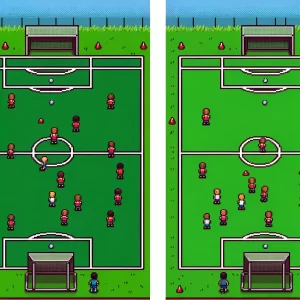
A Dive into Micro-Cycle Planning
Understanding the nuances of coaching strategies is pivotal for success. A recent study titled Comparison of Different Coach Competition Micro-Cycle Planning Strategies in Professional Soccer, offers invaluable insights into this aspect.
Micro-Cycle Planning: A Key to Player Development
A micro-cycle is essentially a short-term training plan, typically spanning a week, designed to balance various types of training loads. In professional soccer, micro-cycles are crucial in preparing players for the physical and tactical demands of upcoming matches. They are the building blocks of a larger training regimen, fitting into broader meso-cycles (spanning several weeks) and macro-cycles (covering the entire season or year).
Variables Tracked
To measure the effectiveness of different micro-cycle strategies, the study tracked critical variables, such as:
- Total Distance Traveled (TD): This measures the cumulative distance a player covers during a training session, providing insight into the overall physical load.
- High-Speed Running Distance: This assesses the distance covered at speeds greater than 21 km/h, reflecting the high-intensity aspects of training.
- Sprint Distance: Tracking distances covered at speeds exceeding 27 km/h, this metric indicates the sprinting demands placed on players.
- Acceleration and Deceleration Counts: These metrics measure the frequency of rapid changes in speed, crucial for understanding the dynamic and explosive aspects of soccer.
Use of GPS Data
The study utilized GPS data spanning four soccer seasons to accurately monitor these variables. This approach ensured a comprehensive and precise analysis of the training demands under different micro-cycle planning strategies.
Training Sessions: When It’s Most Demanding
Interestingly, the research found that regardless of the coach, the most conditionally demanding training sessions occurred furthest from the match day (MD+1, MD-4, and MD-3). Particularly, MD-3 stood out for its focus on sprinting. In contrast, MD-2 sessions were generally less demanding.
Variability Among Coaches
Despite some commonalities, coaches showed variations in their approach, notably in the MD-2 and MD-1 sessions. Coaches Co1 and Co2, for example, proposed higher demands during these sessions. These differences underline how each coach’s style of play affects weekly training strategies.
Implications for Soccer Coaching
The study underscores the importance of a well-thought-out micro-cycle planning strategy in professional soccer. The findings suggest that an effective micro-cycle strategy involves a balance of high and low-intensity training sessions, tailored around the match day. This approach not only prepares players physically but also helps in avoiding injuries and burnout.
For soccer coaches and trainers, these insights are crucial. They highlight the need to adapt training plans not just based on physical demands but also considering the individual style of play and coaching philosophy. The study’s findings can guide coaches in structuring their weekly training sessions more effectively, ensuring players reach their peak performance on match days.
For Players: A Guide to Understanding Training Demands
Players can also benefit from understanding these coaching strategies. Recognizing the pattern and purpose behind training schedules can help them mentally prepare for varying intensity levels throughout the week. It also aids in understanding why certain sessions are more demanding than others and how this contributes to their overall development and performance.
Conclusion
This research offers a detailed look into the intricacies of micro-cycle planning in soccer. For coaches and players alike, these insights are invaluable for developing training strategies that optimize performance and ensure sustainable player development.



